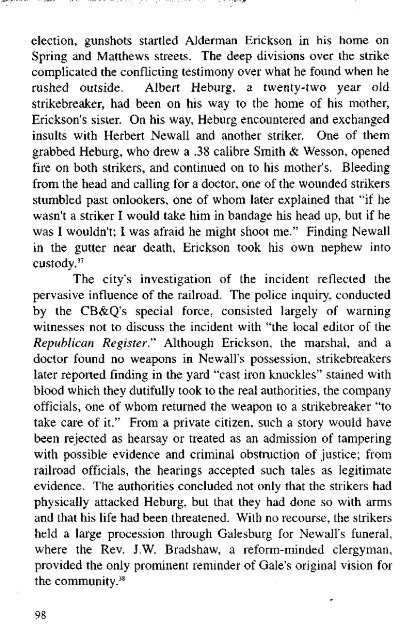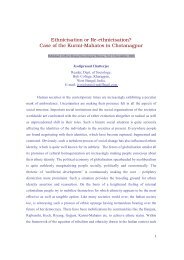"The Cruel Striker War" - NIU Digital Projects
"The Cruel Striker War" - NIU Digital Projects
"The Cruel Striker War" - NIU Digital Projects
You also want an ePaper? Increase the reach of your titles
YUMPU automatically turns print PDFs into web optimized ePapers that Google loves.
election, gunshots startled Alderman Erickson in his home on<br />
Spring and Matthews streets. <strong>The</strong> deep divisions over the strike<br />
complicated the conflicting testimony over what he found when he<br />
rushed outside. Albert Heburg, a twenty-two year old<br />
strikebreaker, had been on his way to the home of his mother,<br />
Erickson's sister. On his way, Heburg encountered and exchanged<br />
insults with Herbert Newall and another striker. One of them<br />
grabbed Heburg, who drew a .38 calibre Smith & Wesson, opened<br />
fire on both strikers, and continued on to his mother's. Bleeding<br />
from the head and calling for a doctor, one of the wounded strikers<br />
stumbled past onlookers, one of whom later explained that "if he<br />
wasn't a striker I would take him in bandage his head up, but if he<br />
was I wouldn't; I was afraid he might shoot me." Finding Newall<br />
in the gutter near death, Erickson took his own nephew into<br />
custody. 37<br />
<strong>The</strong> city's investigation of the incident reflected the<br />
pervasive influence of the railroad. <strong>The</strong> police inquiry, conducted<br />
by the CB&Q's special force, consisted largely of warning<br />
witnesses not to discuss the incident with "the local editor of the<br />
Republican Register." Although Erickson, the marshal, and a<br />
doctor found no weapons in Newall's possession, strikebreakers<br />
later reported finding in the yard "cast iron knuckles" stained with<br />
blood which they dutifully took to the real authorities, the company<br />
officials, one of whom returned the weapon to a strikebreaker "to<br />
take care of it." From a private citizen, such a story would have<br />
been rejected as hearsay or treated as an admission of tampering<br />
with possible evidence and criminal obstruction of justice; from<br />
railroad officials, the hearings accepted such tales as legitimate<br />
evidence. <strong>The</strong> authorities concluded not only that the strikers had<br />
physically attacked Heburg, but that they had done so with arms<br />
and that his life had been threatened. With no recourse, the strikers<br />
held a large procession through Galesburg for Newall's funeral,<br />
where the Rev. J.W. Bradshaw, a reform-minded clergyman,<br />
provided the only prominent reminder of Gale's original vision for<br />
the community. 38<br />
98

















